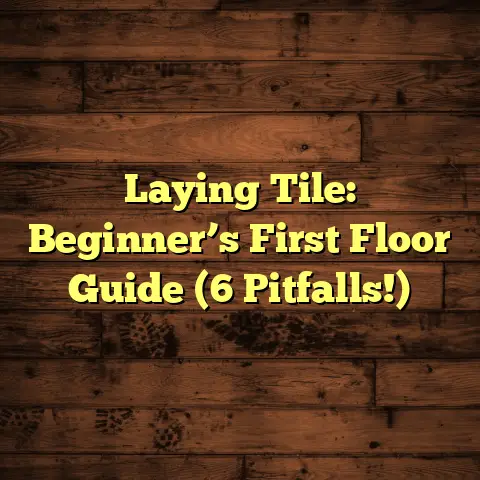Grout Vinyl Floors? Read This First! (1 Pro Says)
Did you ever think vinyl flooring could be grouted? While the idea may seem odd to some, it’s a game-changer in the world of flooring.
What if I told you that grouting vinyl could transform your space in ways you never imagined? I’m here to tell you all about it.
Section 1: Understanding Vinyl Flooring
Alright, let’s get down to brass tacks. What is vinyl flooring anyway?
Simply put, it’s a synthetic flooring option made primarily from PVC (polyvinyl chloride).
Think of it as a multi-layered sandwich: a backing layer, a print layer (where the design comes from), and a clear wear layer on top.
This wear layer? It’s your first line of defense against scratches, dents, and everyday wear and tear.
There are two main types of vinyl flooring you’ll run into: sheet vinyl and luxury vinyl.
Sheet Vinyl: This comes in large rolls, usually 6 or 12 feet wide. It’s great for areas where you want minimal seams, like bathrooms or kitchens.
Luxury Vinyl: Now, this is where things get interesting. You’ve got two sub-types here:
-
Luxury Vinyl Tile (LVT): These are individual tiles that can mimic the look of ceramic, porcelain, or even stone.
-
Luxury Vinyl Plank (LVP): These are planks that look like hardwood.
Why is vinyl so popular? Well, it’s a trifecta of goodness:
-
Affordability: Compared to hardwood or tile, vinyl is much easier on the wallet.
-
Durability: It can handle a beating, especially the luxury vinyl options.
-
Ease of Maintenance: A quick sweep and a mop, and you’re good to go.
But what about this “grout vinyl flooring” I mentioned? That’s where we’re heading next. It’s a way to take the look of your vinyl floor to the next level.
Section 2: The Concept of Grouting Vinyl Floors
Okay, so you’ve got your vinyl floor down. It looks nice, but something’s missing, right? That’s where grout comes in.
Grouting vinyl floors essentially means installing vinyl tiles or planks with spaces in between them, just like you would with ceramic or porcelain tile.
Then, you fill those spaces with grout. Yep, the same stuff you use for regular tile.
Now, you might be thinking, “Why would I do that?” Well, the main reason is aesthetics.
Grout lines add a level of realism to vinyl flooring that you just can’t get otherwise. It makes it look much more like real tile.
Think about it: the grout lines create definition and visual texture. They break up the monotony of a large vinyl surface and give it that authentic tile look.
But it’s not just about looks. Grouting can also add a touch of customization. You can choose different grout colors to complement or contrast with your vinyl, creating a unique design.
I’ve been in the flooring business for over 15 years, and I’ve seen this trend really take off in the last few years.
Homeowners are looking for ways to get the look of high-end materials without breaking the bank, and grouting vinyl is a fantastic way to do that.
One thing I always tell my clients is that preparation is key. You can’t just slap some grout on any old vinyl floor and expect it to look good.
The subfloor needs to be perfectly level, and the vinyl needs to be installed with consistent spacing.
Section 3: The Pros of Grouting Vinyl Floors
Let’s dive deeper into the benefits of grouting vinyl floors:
-
Visual Appeal: I touched on this earlier, but it’s worth repeating. Grout transforms vinyl from “nice” to “wow.” It adds depth, character, and a sense of authenticity.
-
Customization: This is where you can really get creative. You can choose a grout color that matches your vinyl for a subtle, seamless look, or go bold with a contrasting color for a more dramatic effect.
-
Maintenance: Now, this is a bit of a mixed bag, which we’ll get into later. But in general, grouted vinyl is still relatively easy to maintain. The vinyl itself is waterproof and stain-resistant, and the grout can be sealed to protect it from dirt and grime.
Let me tell you about a project I did a few years back. A client wanted a high-end kitchen but was on a tight budget.
We installed luxury vinyl tile that looked like Carrara marble, and then we used a light gray grout. The result was stunning.
Everyone who walked into that kitchen thought it was real marble. It completely transformed the space.
Another advantage I’ve noticed is that grouting can actually help to conceal minor imperfections in the vinyl installation.
If there are any slight gaps or uneven edges, the grout can fill them in and create a more polished look.
Section 4: The Potential Cons
Okay, let’s be real. Grouting vinyl floors isn’t all sunshine and roses. There are some potential downsides to consider.
One of the biggest misconceptions is that grouted vinyl is completely waterproof. While the vinyl itself is waterproof, the grout is not (unless you use epoxy grout, which is a whole other story).
If water penetrates the grout, it can seep underneath the vinyl and cause mold or mildew growth. That’s why it’s crucial to seal the grout properly and re-seal it every year or two.
Another potential drawback is the installation complexity. Grouting vinyl is not a DIY project for beginners. It requires precision, patience, and the right tools.
If the vinyl isn’t installed with consistent spacing, or if the grout isn’t applied correctly, the results can be disastrous.
You could end up with uneven grout lines, cracked grout, or even loose vinyl tiles. Trust me, I’ve seen it all.
So, when isn’t grouting advisable? Well, if you’re on a super tight budget, it might not be the best option.
The extra cost of the grout, sealant, and potentially professional installation can add up. Also, if you’re not willing to put in the time and effort to maintain the grout, it’s probably best to skip it.
I generally advise against grouting vinyl in areas that are constantly exposed to moisture, like shower stalls. While it can be done, it requires extra precautions and careful maintenance.
Section 5: The Installation Process
Alright, let’s talk about how to actually install grouted vinyl flooring.
Step 1: Preparation is Key
-
Subfloor: The subfloor needs to be perfectly clean, level, and dry. Any imperfections will telegraph through the vinyl and affect the final result.
-
Acclimation: Let the vinyl tiles or planks acclimate to the room’s temperature and humidity for at least 48 hours before installation.
-
Layout: Plan your layout carefully to minimize cuts and ensure a balanced look.
Step 2: Installing the Vinyl
-
Adhesive: Use a high-quality vinyl adhesive recommended by the manufacturer.
-
Spacing: This is crucial. Use spacers to maintain consistent grout lines. I recommend 1/8-inch or 3/16-inch spacers for most projects.
-
Cutting: Use a utility knife or a vinyl cutter to make precise cuts.
Step 3: Grouting
-
Mixing: Mix the grout according to the manufacturer’s instructions.
-
Application: Use a grout float to apply the grout, working it into the grout lines at a 45-degree angle.
-
Cleaning: Use a damp sponge to remove excess grout from the vinyl surface. Be careful not to remove too much grout from the grout lines.
Step 4: Sealing
-
Curing: Let the grout cure for at least 72 hours before sealing.
-
Sealing: Apply a high-quality grout sealer to protect the grout from stains and moisture.
Tools and Materials:
- Vinyl tiles or planks
- Grout
- Grout sealer
- Vinyl adhesive
- Spacers
- Utility knife or vinyl cutter
- Grout float
- Grout sponge
- Buckets
- Mixing tools
I can’t stress enough the importance of professional installation. While it’s possible to DIY this project, it’s easy to make mistakes that can be costly to fix.
A professional installer will have the experience, tools, and knowledge to ensure a flawless installation.
Section 6: Maintenance and Care for Grouted Vinyl Floors
Okay, you’ve got your beautiful grouted vinyl floor installed. Now, how do you keep it looking its best?
Here’s a comprehensive guide to maintenance and care:
-
Regular Cleaning: Sweep or vacuum regularly to remove dirt and debris.
-
Mopping: Mop with a mild detergent and warm water. Avoid harsh chemicals or abrasive cleaners.
-
Grout Cleaning: Use a grout brush and a grout cleaner to scrub the grout lines periodically.
-
Stain Removal: For stubborn stains, try a mixture of baking soda and water.
-
Sealing: Re-seal the grout every year or two to maintain its protection.
Products to Use (and Avoid):
- Use: Mild detergents, grout cleaners, grout sealers
- Avoid: Abrasive cleaners, bleach, ammonia
One trick I’ve learned over the years is to use a steam cleaner on grouted vinyl floors. The steam helps to loosen dirt and grime without the need for harsh chemicals.
However, be careful not to over-saturate the grout, as this can damage it.
Another tip is to use mats or rugs in high-traffic areas to protect the vinyl and grout from wear and tear.
If you notice any cracks or damage to the grout, repair it immediately to prevent water from seeping underneath the vinyl.
Section 7: Real-Life Applications and Inspirations
Let’s take a look at some real-life examples of how grouted vinyl flooring can be used in different interior designs:
-
Kitchen: Vinyl that mimics ceramic or porcelain tile, with a contrasting grout color for a pop of visual interest.
-
Bathroom: Vinyl that looks like natural stone, with a neutral grout color for a spa-like feel.
-
Living Room: Vinyl planks that resemble hardwood, with a matching grout color for a seamless look.
I’ve seen grouted vinyl used in everything from modern minimalist homes to cozy farmhouse-style interiors. The possibilities are endless.
One of my favorite projects was a basement remodel where we used grouted vinyl to create a faux-tile floor that looked incredibly realistic.
The client was thrilled with the result, and it completely transformed the space from a drab, unfinished basement into a stylish and inviting living area.
Another trend I’m seeing is the use of patterned vinyl tiles with grout to create unique and eye-catching designs.
You can mix and match different patterns and colors to create a custom floor that reflects your personal style.
Conclusion
So, there you have it: a comprehensive look at the world of grout vinyl flooring. As I’ve shown, it’s an innovative solution that offers a unique blend of aesthetics, affordability, and durability.
While it’s not without its challenges, the potential benefits are undeniable. Whether you’re looking to create a high-end look on a budget or simply want a flooring option that’s easy to maintain, grouted vinyl is definitely worth considering.
The future of home design is all about making informed decisions that balance style and practicality. Grout vinyl flooring is a perfect example of this trend.
Call to Action
I encourage you to do further research, consult with professionals, and visit showrooms to see grouted vinyl flooring in person.
Your next flooring project could benefit from thinking outside the traditional box. Who knows, you might just discover your new favorite flooring solution!





